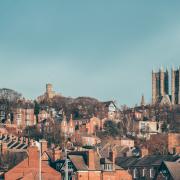Richard Darn takes a stroll off the beaten path and discovers Baytown’s fascinating past

I love getting off the beaten path, but you would be hard pressed to say that Robin Hood's Bay qualifies as an undiscovered gem. It's a tourist honeypot, attracting thousands of visitors each year, drawn by its peerless old world charm and coastal scenery.
But even in Baytown (as locals call it) you can easily find yourself away from the crowds and in relatively undiscovered streetscapes that have barely altered in over 300 years.
On the day I visited the spring sunshine beamed down and the lure of the sea proved too much for most people, with their pace quickening down the village's main street to the beach.
That was my cue to buck the trend and go walkabouts, exploring the scores of passageways.

I can't think of another place with such an extensive network of alleys, each leading to distinctive neighbourhoods, terraced for the most part, but also dotted with weirdly shaped buildings to maximise every last inch of space on the hillside. They are like the veins running through Robin Hoods Bay.
Such is the squeeze that it was once said that a smuggled bale of silk could pass from the seashore to the top of the hill without ever seeing the light of day. You probably don't need reminding that Baytown was Yorkshire's biggest contraband port, where locals waged a war with the excise men to avoid punitive import taxes, originally levied to fight the French in the 18th century.
Everyone seems to have been enmeshed in the trade and the tunnels and passageways that provided a tax dodge (literally) were equally as useful in avoiding the navy press gangs. To escape the clutches of both, locals dashed along 'The Bolts', with their wives pouring boiling water over the pursuers (a smugglers' trail pack is available from village shops full of amazing stories).
All together there are about two hundred cottages, a mix of holiday lets and permanent residences. Many of the buildings are legally protected due to their national importance. With so many people living on top of each other, tall chimneys were the order of the day, all part of a multi-level and stunning roofscape, complete with red pantiles. What immediately took my eye were the doors: their design is apparently unique to the Bay, many a mix of Georgian three panel and six panel types, others more rustic. Painted red, yellow and blue, they add to the gaiety, and many have lovely fan lights. The door knockers too are fantastic, ranging from fish to anchors and even ships, with one plaque on a door I spotted evoking the area's whaling past.
You also come across rare survivors. Cast iron pumps belonging to a past age when water had to be collected, a letter box from the reign of King George V and my favourite, a sublime cod, mouth wide open, and installed in 1887 to collect donations for the RNLI. It's reckoned to be oldest charity box of its kind in the country.
The arrival of the railway in Robin Hood's Bay (1885) was a godsend, with the fishing industry facing decline with the shift to trawlers and deeper ports. Tourism ensued and the place became the haunt of artists such as Scottish painter Dame Ethel Walker (whose studio housed in a 17th century cottage has now fallen into the sea) and Leeds born Owen Bowen.
Another famous resident - marked with a blue plaque - was author Leo Walmsley, who moved here as a child with his parents and used the village as the inspiration for a popular series of fictional books, including the 'Three Fevers and Phantom Lobster'. There's a society dedicated to his legacy that makes a pilgrimage every year.
The last train to call at Baytown departed in 1964 and the tracks were ripped up. But no matter - the same route now provides an excellent cycle and walking route between Scarborough and Whitby.
This part of the coast specialises in superb views and before I took my leave I enjoyed a stroll down to nearby Boggle Hole, less than a mile away on the Cleveland Way. It is possible to make the journey via the beach, but you need to be very careful about the tides, otherwise it's easy to get trapped.
A 'boggle' is the local name for a hobgoblin and this was another smugglers' inlet, which now oozes romance and charm. This is a great place for fossil hunting and also the location of one of England's finest youth hostels. If you stay, don't vanish inside when night falls, but glance up to enjoy a lovely starry sky. If you are very lucky, this is also a good place to spot the Northern Lights.
The Baytown area packs so much into a small area that it represents an embarrassment of riches. But that means there's always something new to discover and an incentive to return soon.



























